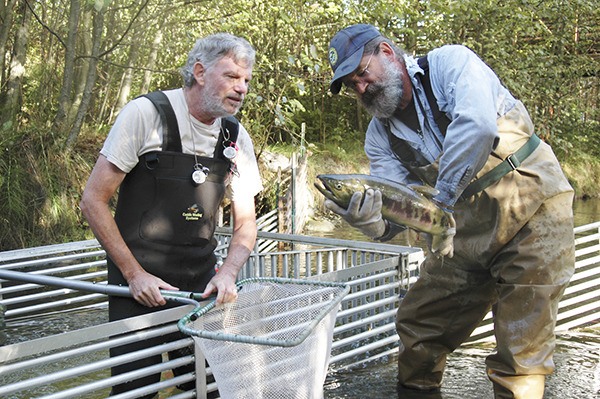For the past 15 years Washington Department of Fish and Wildlife officials, with the support of the Jamestown S’Klallam Tribe, have collaborated with the North Olympic Salmon Coalition staff and countless volunteers to restore a self-sustaining population of summer chum salmon to Jimmycomelately Creek.
This year’s survey season will come to a close at the end of the month, but to date 2,100 fish have made it back and are spawning throughout and above the first mile of creek, Cheri Scalf, project lead and scientific technician with WDFW, said.
Summer chum salmon in the Hood Canal area were listed as a threatened species under the Endangered Species Act in 1999. That same year only seven summer chum were documented to return to Jimmycomelately Creek, just a few miles east of Sequim.
However, last year more than 8,000 summer chum returned to Jimmycomelately Creek. Despite fluctuation since 1999, the overall trend is an increasing one.
Although this year the summer chum numbers are down from 2013, it is likely because of a recent toxic algae (heterosigma) bloom in Sequim Bay that has killed hundreds of the summer chum salmon before they made it into the creek, Scalf said. Additionally, warm temperatures and low stream flows may be contributing factors.
Still, Scalf is optimistic given similar conservation efforts were made at Salmon Creek from 1992-2003 and the returning salmon run since 2007 have been all wild.
As part of their summer chum salmon recovery project, WDFW officials harvested the eggs from a portion of the returning female chum (a female chum salmon has an average of 25,000 eggs) from 1999-2010 and reared them in remote locations, but still within the Jimmycomelately Creek watershed to ensure proper imprinting. Adding to the ongoing conservation efforts, by 2004 the Jamestown S’Klallam Tribe had restored the creek’s natural channel and accomplished major habitat restoration work.
Between the restored habitat and supplementation of “program fish” (fish reared at remote locations), the years of work at Jimmycomelately Creek appear to be a success, Scalf said.
Scalf, with the help of the NOSC volunteers and volunteer “citizen scientists,” is able to document the returning 3-, 4- and sometimes 5-year-old fish shortly after they have spawned and died. Scalf does this by taking scale samples, measuring the length and removing the two “ear stones” known as otoliths. Otoliths are found in all fish species, sharks, rays and lampreys, and help with balance in a similar way the human inner ear provides balance.
Under a microscope, otoliths appear to have similar rings denoting a growth pattern, much like trees. By studying the ring pattern of the otoliths, WDFW officials are able to determine whether the fish is a program or a wild fish and what location the fish was reared at if it is a program fish. Scalf considers the otoliths to be like a “biological bar code.”
By slightly manipulating water temperature at the different hatchery locations, the growth pattern of the otoliths mirror the changes. This technique was preferred to similar identification methods, such as fin clips, because the fish were far too small to handle and if handled the mortality rate would likely outweigh the benefits, Scalf said.
With the couple remaining weeks of the survey season, Scalf’s goal at Jimmycomelately Creek is to collect at least 300 sets of otoliths to get a representative ratio of wild and program fish returning to the creek.
The ongoing work at Jimmycomelately Creek is just one of many similar projects. For more information, visit nosc.org.


